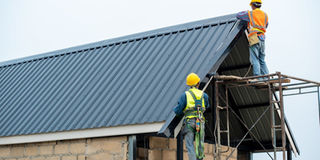What you should know before installing your roof

Make sure that you do inspection in time when the engineer is still on the site so that nothing is left hanging PHOTO/www.gettyimages.com
What you need to know:
Consider the pros and cons of each roofing material depending on the type of the structure and design.
Structures lose shape and beauty towards completion because of the poor planning for roofing. This has affected many landlords, who end up incurring more costs. Some buildings collapse while others look weird.
Selection of the right material
Mr. Mutyaba Edris, a builder, says that one of the crucial things you need to consider is selection of the right material and this includes material quality, price and lifespan of the material, especially the timber maxpanda and iron sheets.
“You should go window shopping at several hardware shops to compare the prices and the qualities on the market. Some shop owners do not want to sell their genuine products first. Instead, they market the poor quality so that they sell out their stock,” he says
Mr. Mutyaba advises that you take your contractor with you, if possible, to choose the best quality depending on your budget.
“Some people opt for metallic roofing especially for the commercial structures. Metals are very genuine and last longer than the timber roofing. Though these latest materials are more expensive than the old fashioned type, it is better to consider their lifespan,” he says
Mutyaba advises homeowners to carefully consider the pros and cons of each roofing material depending on the type of the structure and design and this is best done by an expert.
“While choosing the roofing material, decide if it is for replacing the roof or making repairs. Fixing is cheaper than replacing and if possible, go with material which is easy to fix even if it is more expensive,” he says.
Study the state of the roof frame
Gauge the state of your roof frame before placing the roof in order to ensure that there are no defects such as leaking or missing pins because this may affect the lifespan of your roof.
“It is advisable to roof your house immediately after putting your frame to avoid degradation of material from over exposure to weather elements,” he says
He adds that if you notice any fault with your frame you should fix it first before placing your roof. Inspect your plywood or construction safety nets if they are loose or broken, replace immediately.
“While studying your roof frame, first check the appearance of one section of the roof material to determine if there is need to have a change. This helps to identify the error before it’s too late and also prolong the lifespan of your roof,” he says
Have a budget
Have a final budget which caters for everything you need to have your roof in place and make sure you and the constructor are on the same page.
“The budget will include; framing, painting, fixing and hiring extra workforce if needed. Sometimes constructors delay to complete the work because they want to get extra pay. But if they know your budget and understand you will stick to it, they will also just stick to the schedule agreed on,” he says.
Mutyaba adds that you have a right to ask all the questions about the process to make sure you understand what the engineers are doing so as to avoid making mistakes which cannot be undone.
“You have to make sure that the engineer you have hired has a work permit and a letter from the contractor’s insurance company in case of any damage. He (or she) should also confirm that he has expertise in what he is doing to avoid shoddy work at the end,” he says.
He adds that since the roofing work does not take long, you should agree and pay commitment fee to the builder, and then the balance is paid when the work is done.
“It is very hard to complain about any error when you have made all the payment. Make sure that you do inspection in time when the engineer is still on the site so that nothing is left hanging,” Mutyaba advises.

TRENDING: CONSTRUCTION DRONES
Drone use in the construction industry continues to be one of the fastest growing trends, with usage rising by 239 percent year over year. The technology offers far more uses than just aerial photography for real estate and commercial efforts.
Today’s drones are used for rapidly mapping large areas over long distances, producing valuable aerial heat maps and thermal images. The advancing drone software provides real-time, actionable data that can be used for rapid decision making, further streamlining the entire construction process.
Personal safety and equipment loss continues to be the biggest liabilities in construction. Drones can perform jobs in place of human workers to prevent injury, such as jobs requiring scaling supertall structures. As on-site security tools, drones can be leveraged to reduce labour costs and minimise the risk of theft, keeping projects on schedule and minimising hiccups. More advanced future uses include; monitoring equipment depreciation and incorporating AI to organise moving construction equipment.
Source:bigrentz.com




